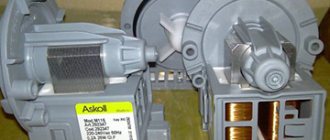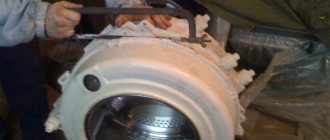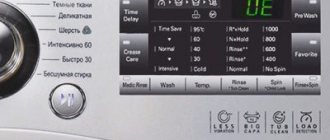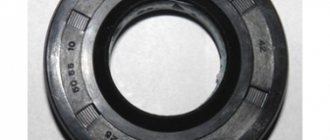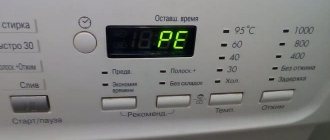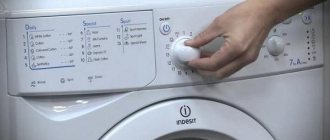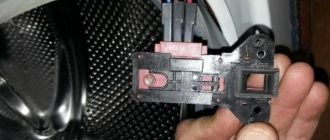Hello everyone reading. Our Ariston washing machine broke down...it worked for 5 years. As it turned out, the drum bearing flew off... It happened like this. When washing or spinning, it started to creak, buzz, etc... After a little googling and watching the video, I realized that it was a drum bearing. First I did the diagnostics myself, as MASTER told and showed in the video =)
According to the identified symptoms in the patient. Diagnosis “bearing” To make sure, I called a technician home. He looked and said that it was a bearing and replacement would cost from 5500-8500 thousand i.e. 50-70% of the cost of the machine itself (as Masta told me), in this situation, add and get a new washing machine (Indesit or LG) for 13-14 thousand
I gave him 300 rubles for the call, said goodbye, closed the door and began to analyze, repair or buy =)) After thinking, googling and deciding to do the repairs myself =)
I did everything according to this video
The only thing better is to buy an internal bearing puller because... The clip got stuck and I had to use a puller =)
Conclusion: Everything is very simple (although at first glance it’s complicated) Don’t skimp on sealant (sp. MOMENT). I spent the evening disassembling and sawing the drum, and the evening was spent going to the store to buy a bearing and glue the drum. I did this. I glued the tank together, then prepared it for assembly and installation of everything in the machine, drank coffee and put everything back into the washing machine. The next day I started it up, everything works, no leaks. The main thing is to put on all the pipes, otherwise I forgot to put on the only one (the bottom one under the tank) so water leaked))))) and despair immediately surged))) I bought SKF bearings + seal, a good sealant gun and the sealant itself, bolts with washers and nuts, drill and so on. that's 1500 for the whole repair Well, a couple more hands when assembling and disassembling won't hurt =) Ps excuse my French. shhh... Once upon a time at school I wrote the Unified State Exam at 4
There are no completely silent washing machines - no matter how gently the device operates, it may make a little noise during the spin cycle. If extraneous noise, vibration or whistling is added to the usual rumble, it is advisable to stop the machine until the cause of the noise is determined.
If the loud noise is accompanied by strong vibration, it is most likely caused by improper installation of the washing machine. The washing machine is probably installed on an uneven surface. Special plastic attachments that fit onto the legs of the washing machine and ensure their tight fit to the floor will help compensate for excessive vibration.
The machine must be installed on a hard and level surface. The best option is a regular cement floor without any tiles. When installing, it is advisable to use a horizontal level - it should not “walk” when pressing on the corners. It is also necessary to inspect the condition of the rubber gaskets on the legs of the machine - they may have defects.
If the new machine makes a lot of noise and clatter when first started, it is possible that the transport bolts located on its rear wall were not removed during its installation. The fact is that these fasteners are used exclusively when transporting the washing machine; washing together with these bolts is not provided for by the design. These bolts must be removed before using the washing machine. If you need washing machine repair in Saratov, contact our company.
The machine can make excessive noise during washing for several reasons. Before performing diagnostics, the unit must be de-energized. The cause of loud noise can be either damage to any of the components of the washing machine or its improper operation.
Linen imbalance
Uneven distribution of laundry in the drum can lead to increased shaking and vibration during the spin cycle. This happens especially often in LG washing machines. This can happen if you load laundry into the drum in one lump, haphazardly. An imbalance can also be caused by an overloaded washing machine. In this case, you need to stop the wash and carefully arrange each item of clothing in the drum. If the machine is overloaded, it is better to remove some of the clothes from it, since in addition to increased noise, this state of affairs leads to a deterioration in the quality of the wash.
Main causes of failure
The first and main reason for wear of the drum bearing in a washing machine of any brand, be it LG, Samsung, Indesit, is damage to the sealing lip (oil seal). Its task is to ensure the tightness of the tank and prevent water from spilling out of it.
Water helps wash out the lubricant, the balls rotate dry, which leads to breakage of the part. Most often, the separator is the first to break; its parts contribute to further destruction of the assembly, and the lack of alignment of the balls allows the shaft and the drum attached to it to “walk.”
Constant overload also contributes to wear. To avoid this situation, many manufacturers use a system that blocks startup if the drum is overweight. Also, the cause of the breakdown may be a manufacturing defect, but reputable manufacturers purchase only high-quality parts, however, a bad bearing may have been installed during a recent repair.
Wear of washing machine bearings
If everything is in order with the placement of the laundry, there is most likely a problem with some part of the washing machine. First of all, the serviceability of the bearings is checked. So, if they become unusable, during operation the washing machine will make a sound reminiscent of the roar of an airplane. You can check the condition of the bearings by grasping the edge of the drum with your hand and, pressing lightly, turn it in one direction and the other. Damage to the bearings will be indicated by intermittent, strained movement of the drum. If the drum rotates freely, then the bearings are fine.
Loosening the drum pulley
If intermittent clicks are heard during operation of the washing machine, in particular during the spin cycle, it means that the drum pulley mount may have failed. The fastening nut or bolt may become loose during operation of the washing machine and become loose. Because of this, the pulley begins to move freely and make extraneous noise.
The situation can be corrected by completely unscrewing the loose nut or bolt and re-tightening it, additionally using a moisture-resistant sealant - it can prevent the fasteners from loosening again.
Foreign object
Grinding and noise during washing can be caused by foreign objects getting into the space between the tub and the drum of the washing machine. Often small metal objects fall out of pockets, buttons come off, etc.
You can get rid of extraneous noise by removing the laundry from the washing machine. To gain access to the space between the tank and the drum, the tubular heater must be removed. Through the resulting hole, you can use long tweezers or a magnet to remove the object. After this, the heating element is installed in place.
Damage to tank counterweight mounting
To give the washing machine tank stability, counterweights are used to equalize its position. They are connected to the tank with bolts or self-tapping screws. Due to prolonged use of the washing machine, the fastenings may become loose and the counterweight may hit the tank body. Long-term operation of the washing machine with a damaged tank mount can lead to destruction of the counterweights.
To check the condition of the counterweights, a detailed inspection is necessary. Using a flashlight, all hard-to-reach places are illuminated and fasteners are probed. If a loose fastener is found, it must be tightened. The destroyed counterweight needs to be replaced.
It is not difficult to replace the counterweight; to do this, you need to unscrew the bolts with which it is attached to the tank. Sometimes it is necessary to replace not only a part, but also its fastening.
Possible malfunctions of the Indesit washing machine in electronics and electrical
Since Indesit washing machines contain many sensors and a complex microcircuit that are subject to constant stress in the form of vibration, this leads to periodic problems in the electrical circuit. Here are the most common problems with this brand of household appliances:
Network filter
Just behind the wire entry into the housing is a small block with a visible spool of wire. This element protects against frequency surges in the network and various impulses that can damage equipment located further down the chain. Unfortunately, for the Indesit brand, failure of the surge protector is one of the most common malfunctions. This is not due to poor contact or small cross-section of the wires, but due to the accumulation of condensation on the device.
Signs of such a breakdown will be a complete lack of functioning (starting the program, drawing water and spinning does not work). The only thing that will help here is to replace this small part, which will require unscrewing the housing cover and re-soldering the contacts to the new filter.
Control module
Indesit washing machines with mechanical controls last quite a long time, 8-12 years. Due to the simple power switching circuit on the programmer, they are reliable and easy to operate. Models with one switch, rather than two, are the most unpretentious. Replacing the programmer is the rarest failure.
But Italian technology with electronic control and large displays, although much more convenient than its predecessors, is also more “capricious”. From time to time, the control module may generate an error in the operation of the program, or even fail. Signs of such a malfunction in the Indesit washing machine will be:
- random flashing of indicator lights;
- burning codes 09 and 18 on the screen;
- draining the water immediately after collecting it;
- too short or, on the contrary, long washes;
- no spin.
Although such a unit is more complex than a programmer, its repair does not consist of replacement, but of reflashing. To do this, you will need a master with a computer and a special program. By re-entering the software, you can restore normal operation of the entire device, which will save time and money on repairs.
heating element
Some Indesit washing machine models have a steel heating element without additional coating. This promotes accelerated adhesion of water deposits to the surface of the heating element. Such a “crust” leads to a deterioration in the heating of the liquid and the element’s own overheating. Ultimately, the heating element burns out and the machine washes only in cold water.
This malfunction of the Indesit washing machine can be determined by the cold glass door and poorly washed powder in the supply container. You can finally diagnose a burnt-out heating element by disassembling the housing and “ringing” its two contacts with a tester. The terminals are on the right and left, and in the middle there is a contact for grounding.
Repair consists of installing a new heating element with the same power and size.
Pressostat
At the bottom of the tank of the Indesit washing machine there is a pressure switch that determines the presence of water level. If it burns out, then the device does not know whether there is liquid in the tank, so the washing programs stop working (no water is collected), rinsing, spinning (the control module does not receive data that there is water and it needs to be removed).
The device is mounted on a small plate at the bottom of the case. To reach it, you may have to turn the unit on its side. By unsoldering two of its contacts and installing a new one, the problem is completely solved.
Tachogenerator
The Indesit company installs a speed sensor on all its machines, which has the shape of a metal ring with a stator (electric winding). A magnetic rotor connected to the axis of the drum rotates inside this device. The leads are soldered to the wires and tell the main unit how fast the rotation is during washing and spinning.
A malfunction of the Indesit washing machine is manifested in the fact that the spin speed is too high (800 rpm is set for comfortable ironing of shirts, but they are overdried), or at very low speeds (water drips from the laundry after being removed from the drum). If such signs are detected, you will need to disassemble the housing and get to the back side of the drum, where the sensor is located. Replacing it with a similar one eliminates the problem of weak or strong revolutions.
Engine
Among the malfunctions of the Indesit washing machine, there is also a break in the electric motor winding. Most often, the manufacturer uses engines with a square body and a belt transmission of torque. They are installed in the lower right corner, and rotation is carried out through a pulley system.
Burnout of wires in the winding manifests itself in the cessation of drum revolutions. At the same time, all other functions work (the program lights are on, water can be filled and drained).
To finally detect the breakdown, the machine body is disassembled to gain access to the electric motor contacts. They are displayed on the side and are in a white block. The tester “rings” the winding, and if the current does not pass, then the motor burns out.
There are two options for repairs: rewind the motor (if you have a good specialist for this) or install a new motor that matches the mounting holes and power.
Button contacts
A broken button contact is the most common malfunction of an Indesit washing machine. Due to strong vibration and thin wires, the terminals inside the electrical unit fray or fall off. This manifests itself in the absence of a light indication on a certain button (pre-wash, add speed, wash without spin, start button) or a reaction to pressing it.
To check the version, you need to remove the top cover and use your fingers to pull each wire leading to the control panel. If a loose cable is found, then using a soldering iron and tin you can return it to its place.
UBL
To prevent the apartment from being flooded with water when the door is poorly closed, manufacturers equip Indesit washing machines with a hatch blocking device. After closing the door and pressing the start button, the system locks the lock and will not allow it to be opened until the process is completed.
If this unit is broken, then the control module does not receive information about the state of the door and “thinks” that it is still open, so the equipment does not work further.
You can recognize such a malfunction of the Indesit washing machine by the buttons that continue to light, but there is no characteristic locking click when you press start of washing. The repair consists of replacing the UBL, which is located inside the housing and has an electronic-mechanical effect.
Solenoid valve
An electromagnetic valve is used to regulate the water supply to the tank. The Indesit brand uses unit models with one and two coils, which depends on the specific type of equipment.
They operate on the same principle: water enters through one channel and exits through another. Between them there is a barrier plate that seals the vestibule, which receives commands from the control module. Shutting occurs by supplying power to the electromagnetic part of the assembly.
When a failure occurs, the following symptoms may appear:
- water is not collected at all;
- too long accumulation of liquid in the drum;
- At rest, water appears in the tank spontaneously.
To fix a problem with the valve of the Indesit washing machine, you will need to disconnect the supply hose and remove the top cover. The valve is secured with two screws that can be unscrewed. You can try to blow out the inlet in case plaque has gotten into it, and restart the unit after returning the unit to its place. If the above symptoms continue, the solenoid valve will need to be replaced.
Loosening the surge protector
If you hear a knocking sound from the washing machine drum, both during washing and spinning, the power filter may have become loose. The surge protector is located on the back wall of the washing machine and is used to rectify the current to the permissible 220 V in case of a power surge. A loose filter can hit the tank and body of the washing machine during washing, which causes knocking.
To eliminate the malfunction, it is necessary to carefully fix the filter again or replace its fastening.
Replacing bearings and seals in a washing machine
Replacing bearings in a washing machine is a rather complex and responsible repair that requires experience, the skill of a craftsman and special devices for pressing in and out of the machine’s tank bearings.
The question arises: Should I replace the bearings or buy a new washing machine?
At this time, almost all manufacturers of washing machines increase the spin speed of the drum ( up to 2000 rpm ), which significantly reduces the service life of the bearing assembly. Therefore, after 4-5 years of intensive use, this unit objectively requires replacement . But the machines were purchased in the mid-1990s, where the spin speed did not exceed 800 rpm. , still work without the need to repair the bearing assembly.
After replacing the bearing assembly, your machine will work like new.
We replace bearings in washing machines with horizontal and vertical loading.
The cost of replacing bearings depends on the make, model and complexity of disassembling the machine.
If the car does not have a collapsible tank , two repair options are offered:
The first will be associated with the need to purchase and replace the entire tank, which will include a tank, a drum, already with new bearings and an oil seal, a pulley, and drum activators. (most often these are cars manufactured after 2010: Hotpoint-Ariston, Indesit, Candy, Electrolux, Zanussi, Aeg, Gorenje and others)
The second option is manual cutting of a non-dismountable tank and its subsequent connection.
The procedure for replacing bearings is generally inexpensive and relatively quick, which will save you time and money. The technician will come to you with all the necessary tools, a set of original bearings and an oil seal specifically for your washing machine; will replace worn bearings and oil seals in 3–4 hours. at your home (or will take you to the workshop); will issue an official receipt (strict reporting form) with a repair guarantee for a period of 12 months. The warranty covers both the replacement service itself and the new bearing group.
Bearing replacement cost:
The cost of replacing bearings (for a collapsible tank) starts from 3,300 rubles,
and the cost of replacing bearings (not a collapsible tank) is from 5,500 rubles.
The approximate cost of bearings is from 90 rubles. up to 2860 rub., oil seal from 70 rub. up to 2250 rub., tank cross from 1370 rub. up to 6820 rubles, tank assembly with drum from 4540 rubles to 38230 rubles.
A more accurate cost depends on the complexity of disassembling the washing machine, as well as its make and model.
Included in the price:
1. Disassembly and assembly of the washing machine.
2. Disassembling and assembling the washing machine tank.
3. A set of original bearings and oil seal (external and internal - for washing machines with horizontal loading, right and left calipers with fused bearings - for machines with top loading), lubricant, sealant and screws for the tank.
4. The work of a master to replace the oil seal and both bearings.
5. Checking the operation of the bearing unit.
How to call a specialist?
Applications for replacement of bearings are accepted daily, from 8 a.m. to 10 p.m. by phone or using an online application.
8 (985) 181 – 08 – 88
8 (985) 181 – 02 – 88 (Whatsapp)
Leave a request for repairs
Important! When contacting, please provide the following information: Your contact information: name, phone number and address, make of the machine, if possible, send a tag with the serial number and product code of the machine and the day and time of arrival of the technician that suits you.
To carry out repairs and select spare parts for your washing machine, you need to know its model and serial number.
The exact model of the machine is indicated on the tag on the body of the washing machine or stickers, as well as in the operating instructions. If you have already purchased replacement bearings yourself, please indicate only the make of the machine. For example, ELECTROLUX EWT 1367 VDW.
places where washing machines may contain a sticker with all the necessary service information.
1. Under the hatch door on the body. Most often, on front-type washing machines, the serial number is located on a sticker under the hatch door. Either on the door itself or on the body. In most cases, the number consists of numbers, less often of numbers and letters .
2. On the back side of the pump filter hatch. On vertical models, a sticker with a service number is most often located on the inside of the small hatch that covers the pump filter.
3. On the back wall. The back wall of the washing machine is a traditional place for all kinds of service information. If you couldn’t find a sticker with a number on the front, then it was probably preserved on the back wall.
4. In the passport or instruction manual. Finally, the serial number can sometimes be found in the documents that come with the purchase of the washing machine. As a rule, the number is located in the passport or warranty card.
The arrows show the location of the tags.
washing machine manufacturers encode on a tag (sticker) what they produced, when, where and from what parts. This information is encoded in two sequences of numbers (letters) product and serial numbers. Their combination is unique and applies only to one specific instance of the washing machine.
Please take a photo of these tags
Technology for replacing bearings and oil seals:
Attention! Regardless of the degree of wear, the outer and inner bearings need to be replaced.
Top loading washing machines:
1. Remove the side walls, drive belt, and unscrew the pulley. The two bearings are located inside removable plastic supports on either side of the tank. Both bearings are replaced (assembled with plastic calipers).
2. The plastic calipers (hubs) are unscrewed.
3. After dismantling the caliper, the bearing seal is removed.
4. The seat of the oil seal and bearing on the shaft is thoroughly cleaned.
5. The new caliper and the oil seal seat on the shaft are lubricated with waterproof lubricant.
6. The lubricated new caliper with bearing and oil seal is reinstalled.
7. The entire machine is assembled.
Washing machines with horizontal loading and with a collapsible tank:
1. The top cover, the detergent tray, the instrument panel with the control module are dismantled and all connectors are disconnected.
2. The water level sensor, detergent dispenser, filler pipe and water supply valve are dismantled.
3. The rear or front wall, counterweights, drain pipe, shock absorbers, belt, pulley, noise filter and electric motor are dismantled.
4. The hatch cuff, bottom panel and front strip are dismantled.
5. The tank is removed, disconnected and the drum is removed.
6. Old bearings are pressed out from the forecastle body or sometimes from the shaft: external and internal.
7. Places where the oil seal and bearings fit on the shaft, as well as in the forecastle body, are thoroughly cleaned.
8. The production of the bushing and crosspiece shaft is checked. ( if the bushing diameter is 1-2 millimeters smaller than the inner diameter of the oil seal, the tank crosspiece will need to be replaced ).
9. New bearings are pressed into the forecastle body and an oil seal is put on the inside (the oil seal is completely filled with lubricant, and lubricant is also applied to the bushing of the drum crosspiece)
10. The forecastle tank with new bearings is put on the drum shaft and sealed with sealant to the second half of the tank.
11. The washing machine is assembled and checked in the rinse-spin mode.
Direct drive washing machines:
When drum play occurs due to bearing wear, the stationary Hall sensor and motor coils (stator) are very vulnerable because they are located close to the rotating permanent magnet cover (rotor). The rotor can damage the motor coils or damage the Hall sensor.
Attention! If the bearings are noisy in these car models, you need to replace them immediately; if you delay replacement, repairs will be more difficult and expensive.
Signs of bearing failures:
Important! If the washing machine is no more than 4 years old, then these signs may indicate another malfunction, which most likely does not relate to the bearings.
1. This has never happened before: strong noise, rumble, knocking, creaking, crackling, loud buzzing or whistling during the spin cycle.
2. Leaks at the bottom in heating modes (lubricant residues with water). Rusty stains on the tank body inside the car. If this water drips onto the electric motor, the washing machine may smoke and break plugs.
3. Stains appeared on the linen: oil stains, when the lubricant was not washed out of the oil seal, and rusty stains from bearing corrosion.
4. Jumps or vibrates strongly during the spin cycle.
5. The drum rotates poorly or does not rotate at all, the bearings are badly worn or destroyed and the drum jams from contact with the tank.
6. The spin does not work well or the machine does not spin at all.
7. Metallic grinding noise during operation or the drum is jammed or has fallen into the tank.
8. The drum wobbles when pressed by hand, not together with the tank, but separately (strong play)
9. The drive belt constantly falls off and there may be a smell of burnt rubber.
10 Stops during washing, programs are not executed.
The choice between self-repair or seeking help from a specialist depends on the complexity of the breakdown and the presence of associated damage, which can only be identified based on thorough diagnostics and many years of experience. If you have no previous experience in repairing such equipment, then it is better not to try to disassemble the machine. Such actions can only worsen the problem, and repairs will cost much more. Moreover, repairs are not so expensive that you waste your time buying the necessary tools, studying technical documentation and searching for the necessary spare parts.
After the repair has been completed, a receipt must be drawn up with a contract, a work acceptance certificate and a guarantee (Strict Reporting Form), which will indicate your details, the make and model of the washing machine, the work performed and the warranty period for them. Using this receipt, you can apply for warranty repairs at any time. The warranty period for work performed is from 2 to 12 months, depending on the type of repair and the part being replaced.
Washing machines from manufacturers that we repair
Failure of shock absorbers or springs
Shock absorbers are used to dampen sudden vibrations during washing. The result of prolonged use of the washing machine may be a loss of elasticity. In order to check the serviceability of the shock absorbers, it is necessary to remove one of the parts of the washing machine body. You must press the tank from above so that it drops 5–6 centimeters. Next, you need to sharply release the tank and watch how it returns to its previous position. So, if the tank returns smoothly, then the shock absorbers are in order. If it returns to its previous position abruptly and begins to vibrate, it means that the shock absorbers or springs, depending on what is used in the washing machine, need to be replaced.
First of all, the gasket between the cylinder and the piston is damaged and, as a result, both parts are deformed. Ultimately, the situation may reach the point where the shock absorbers, stretching, reach the bottom of the washing machine body and knock on it. In this case, the stretched parts must be replaced. If one element of the shock absorber is damaged, the entire part must be replaced, since manufacturers do not supply such components.
Springs are used to fix the tank in the machine and return it to its highest point during vibrations. Springs are damaged due to natural wear, mainly at the attachment point. One end of the spring is attached to the body, the other - to the tank of the washing machine.
What affects the frequency of malfunctions in the Indesit washing machine?
The Indesit company was founded in Italy, but now has factories in many countries around the world, which has made its products cheaper for the end consumer. The most popular and sought-after models from this brand today:
- BWE 81282 LB - with a huge display;
- BWSB 50851 – with a very affordable price;
- BTW D 51052 W - with vertical loading.
In general, this is a reliable technique that can serve for many years, but even it breaks down from time to time. The nature of breakdowns and their frequency for this particular brand depends on the following factors:
- Indesit washing machines come with vertical and horizontal loading types. In the latter, the hatch cuff leaks more often, since it undergoes increased loads to ensure tightness.
- The type of drive for transmitting torque is direct or belt. When using pulleys and a belt, increased vibration and breaking of components occurs, which contributes to the rapid failure of bearings and bushings.
- The frequency of malfunctions in the Indesit washing machine is also affected by correct installation. If the horizontal is incorrectly set, one side will undergo increased loads, which will accelerate the wear of mechanical parts.
- How often the machine is used (every day or a couple of times a week) naturally affects its trouble-free service life.
When faced with a malfunction, you don’t need to be scared and think that you will now have to buy new equipment - most breakdowns can be fixed in a few hours if you have the tools and spare parts. Some problems can be fixed even with your own hands. But first you need to diagnose the malfunction, determining exactly which unit or part is damaged.
Drain pump clogged
When using a washing machine with hard tap water, limescale deposits may form on some of its components.
Plaque, grains of sand and dirt that accumulates after washing can clog the drain pump filter or its pipe; in this case, either the washing machine does not drain water or the machine will make increased noise when draining water . To eliminate the problem, you need to clear the filter from the blockage. In most washing machine models, the filter is located near the bottom of the front panel of the case. Basically, the filter is hidden behind a small decorative panel. You can remove the filter by turning the handle located on its surface counterclockwise. The filter needs to be cleaned and installed in its original place.
Diagnostics with partial disassembly of the washing machine
To finally make sure that it is necessary to dismantle the tank and replace the bearings, you need to partially disassemble the washing machine. Basically, all you have to do is remove the back panel. It is important not to forget to completely turn off the power to the machine and disconnect the water supply and drain hose before starting work.
The sequence of actions directly depends on the brand of a particular device. In the case of popular models of Ariston washing machines, it is enough to unscrew the bolts holding the top cover, slide it and remove it. After this, all that remains is to unscrew the screws around the perimeter of the back panel and remove it.
Next, you need to carefully examine the inside of the washing machine; for convenience, you can move it away from the wall and move it to a well-lit place or use a flashlight. A cause for concern will be drips coming from the center of the tank.
Washing machine bearing replacement and repair
Even the most expensive and good car can break down after many years of service. Some spare parts may fail, but most often the parts that need to be repaired are those that bear serious physical load, for example bearings. Determine that a washing machine bearing needs repair
It’s quite simple: if during the washing process there are extraneous noises, vibration increases, the unit begins to tap, the bearing needs to be replaced as soon as possible.
Of course, it is better to invite a professional technician from Service-Don to repair the unit, but if you have repair skills, you can easily replace the bearing yourself.
Features of repairs with vertical loading
Here the drum is supported by 2 axle shafts and 2 bearings. With such a reliable design, they fail infrequently, usually when there is some other failure.
They are often damaged by water penetrating through a faulty seal. Rusting and steadily becoming clogged with dirt, the bearing eventually fails.
Repairing such machines is much more convenient. When communications are disconnected, 2 side covers of the housing are removed, and access to the work area is provided.
The bearing on the side where there is no drive pulley is replaced first. To do this, the caliper is removed - a ready-made set of bearings and oil seal enclosed in a housing.
The calipers of the same machine have different thread directions. On the side where the pulley is missing, it is right-handed and unscrews counterclockwise. On the reverse side, such a part has a left-hand thread and is unscrewed clockwise
The seat of the oil seal, as well as the shaft itself, is freed from contamination. When installing a new bearing, it is necessary to avoid distortion of the sealing ring.
Otherwise, it will not be able to prevent fluid leakage, which will cause new bearing failure.
Changing the caliper on the motor side begins with removing the belt and drum pulley. Then comes the turn of the grounding block. Next the caliper is unscrewed. The shaft and seat, as in the first case, are thoroughly cleaned.
A serviceable oil seal is installed in its proper place, and the caliper is tightened. There is no need to put in much effort, because the carving is made on plastic. Assembly, as usual, is carried out in reverse order.
We also have a separate article on our website that discusses in detail the process of replacing bearings in an Indesit washing machine.
Work order:
What tools will be needed for repairs?
Depending on the features of the washing machine, the set of tools may vary. The internal structure of cars of different brands varies significantly. However, for all washers you will need:
Open-end wrenches, sizes from 12 to 19;
Socket wrenches of similar sizes;
Hex keys (set);
Hammers – regular and rubber;
Phillips and flathead screwdrivers of different sizes;
Bearing knockout (you can use a chisel with a blunt end).
Spare parts – oil seal and bearing for the drum;
Rags, sealant, electrical tape.
Washing machine repair (bearing replacement
) begins with an almost complete disassembly of the device. Masters from “Service-Don” (Rostov region, Rostov-on-Don, Bataysk) recommend recording in detail the sequence of their actions or even taking photographs, so that later unnecessary details do not suddenly appear during collection.
Procedure for front-loading washing machines:
The machine is disconnected from communications (network, water supply, drainage);
The back and top panels are unscrewed and removed, the order depends on the design of the unit;
The fixing screws are unscrewed and the control unit is removed;
The loading hatch is opened, the cuff clamp is removed, then the cuff is tucked inside;
The remaining fasteners are removed and the front wall is removed;
All obstacles to loosen the clamp are removed;
The heating element is dismantled, strictly recording the order in which the wires are connected. Masters recommend photographing every action, or at least writing it down on a piece of paper, when repairing any washing machines. Bearing repair by hand
otherwise, it may lead to the appearance of “additional” or “extra” parts, subsequent calls for service and a significant increase in the cost of repairs;
Remove the wires, pipes, drive belt - all connections between the body and the drum tank. Then unscrew the engine;
Take out the engine, remove the drum tank, place it on a flat, comfortable surface for subsequent replacement of bearings.
Possible malfunctions of the Indesit washing machine in the mechanical part
Problems in the operation of the Indesit washing machine also occur in the mechanics, which leads to water leakage, grinding and blocking of rotation, as well as the inability to drain. Here are the most common breakdowns in this category:
Drum axle bearing or bushing
If you hear a grinding or squeaking sound when the drum rotates, then the malfunction of the Indesit washing machine lies in the failure of the bearing located between the central axis and the container for loading laundry. This usually happens after prolonged use for 6-8 years. The lubricant dries out and the assembly begins to crumble due to heat and mechanical stress.
Depending on the model of the washing machine, it is possible to get the bearing out in different ways: in one case, a pulling device is used, and in the other, you will need to saw the outer wall of the drum along the seam and work from the inside. For such work, it is best to invite a master. After installing a new bearing, thoroughly lubricate it with grease.
The sleeve it fits into has three or four arms for securing. Sometimes the walls of the sleeve break off and fall into the drum. This manifests itself in noise during washing and spinning. From time to time, small iron objects or shavings can be found in the drain filter. Replacing a cross with new walls is also difficult and requires the intervention of a specialist.
Feed filter
This is a malfunction that periodically occurs in all washing machines, including the Indesit brand. A filter is installed in front of the faucet in the drainage line to the washing machine and at the entrance to the housing itself, trapping small particles, plaque and rust.
When capacity is reduced, water will flow slowly or stop altogether. The signs are a delay in starting, even though the indicators are working normally. To correct the situation, sequentially unscrew the above places and remove the blockage.
Impeller jamming
Another mechanical malfunction of the Indesit automatic washing machine is the jamming of the pump impeller, which is responsible for draining the water during rinsing and spinning. The unit is located immediately behind the drain filter, and is made in the form of a plastic propeller with three blades. Rotating from a small electric motor, it pumps out liquid.
If iron coins, hard objects forgotten in a pocket, or disintegrating parts of the drum bushing get into it, the blades may lock. This will manifest itself in the form of a humming pump and undischarged water in the tank. To troubleshoot the problem:
- stop the program;
- unplug the device from the outlet;
- unscrew the drain plug;
- drain the liquid;
- shine a light into the impeller and make sure that the foreign object is there;
- pry it with tweezers and pull it out.
Leaks from under the door
Mechanical malfunctions of the Indesit washing machine include leakage from under the door during operation. This is due to wear of the cuff responsible for sealing. There may be two reasons for this: the rubber on the cuff has shrunk and become thinner, so the tightness of the hatch closure has decreased, or the cuff has been punctured by a hard object.
In the first case, you will need to purchase a similar cuff, suitable in size and fastening. Its installation is quick and completely solves the problem. The cost of such repairs is low. In the second case, it is necessary to disconnect the cuff, seal it and turn the damaged part towards the top of the hatch, releasing the water pressure on this part.
Clogged drain filter
The most common malfunction in an Indesit washing machine, which can be fixed in 5 minutes, is a clogged drain filter that allows dirty water to pass through for the next rinse cycle or spin cycle. Threads, hair and small objects can get stuck in it, and over the years a decent layer accumulates, creating a jam.
To repair an Indesit machine yourself you will need:
- stop the program;
- turn off the power;
- unscrew the drain plug;
- remove all debris from its conical or mesh part (depending on the model);
- check the cleanliness of the compartment into which it is screwed;
- put everything back in place.
Strong vibration
Owners of Indesit washing machines also complain about periodic strong vibration during washing or spinning. Although the device has a shock absorption system that can fail, most often the cause is improper distribution of the laundry in the drum, which can be corrected by stopping the program and rearranging the items (this can only be done during the period without water - between rinses).
Indesit washing machines will last a long time if you respond to detected faults in a timely manner and carry out repairs correctly. If you do not have the necessary skills or tools, it is better to call a specialist.
Thematic materials
4 Best Direct Drive Washing Machines
4 Best Front Load Washing Machines
4 best inexpensive washing machines
5 best Asko washing machines
6 best Hotpoint-Ariston washing machines
5 best Ardo washing machines
10 best semi-automatic washing machines
8 best Hansa washing machines
10 best washing machines
Disassembling the tank and directly replacing the bearings
IMPORTANT: The disassembly process must be strictly recorded or remembered.
Prepare enough free space around the drum;
Remove the rubber bearing seal. First, mark its previous location on the drum with a marker;
Place the tank with the pulley up to make dismantling as convenient as possible. Unscrew the fastening bolt (which secures the pulley to the shaft) and remove the pulley. The bolts may be oxidized, making them very difficult to unscrew. To simplify the task, the bolts are sprayed with WD-40 aerosol, and after 40-50 minutes they are easily unscrewed;
Press the shaft with a rubber hammer. You can use a regular one, just carry out the manipulation using a wooden block;
Having unscrewed the drum tank, release the shaft;
Remove dirt and wipe all parts of the washing machine, then inspect them for additional damage;
If everything is in order, use a knockout or a blunt chisel to knock out the bearing;
Remove old seals;
Treat the socket with lubricant;
Install the seals, then use a hammer and a hammer to press the new bearing into the socket.
Common replacement mistakes
Please carefully study the following recommendations so that replacement does not become an expensive repair:
the pulley is broken, you can’t pull it, just rock it slightly to the sides and pull lightly;- breakage of the bolt heads; if the bolt does not fit, spray WD-40;
- break in the temperature sensor wire, be careful with the tank lid;
- the moving unit is damaged;
- The gasket of the moving unit has not been replaced;
- All sensors and wires are not connected during assembly.
So, you are convinced that replacement is quite a labor-intensive task, but doable if you have at least a little experience working with equipment.
Source


